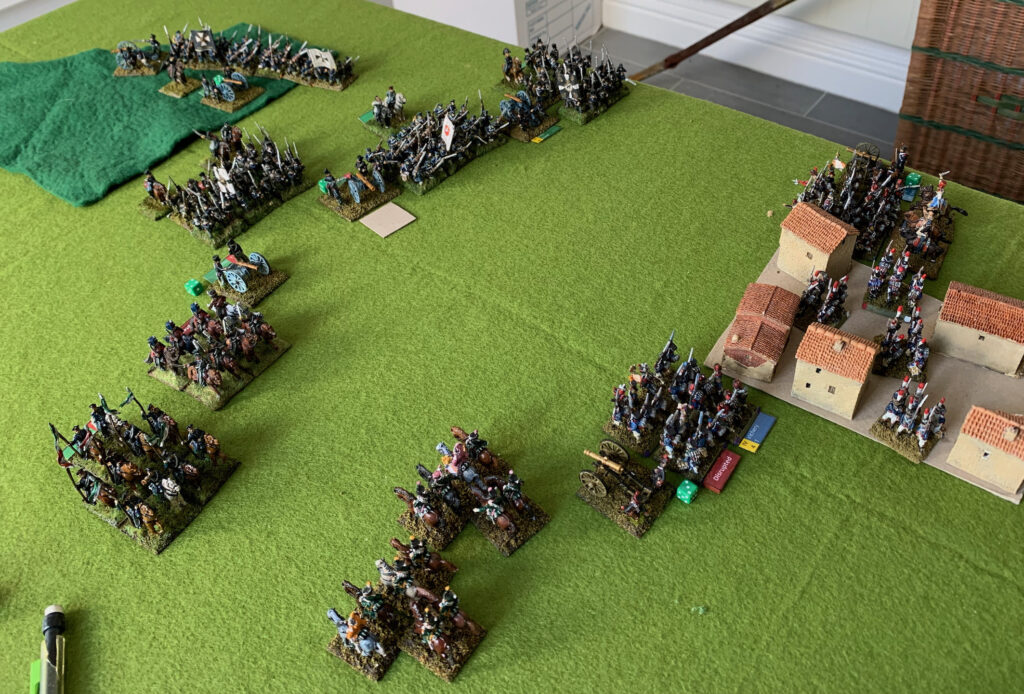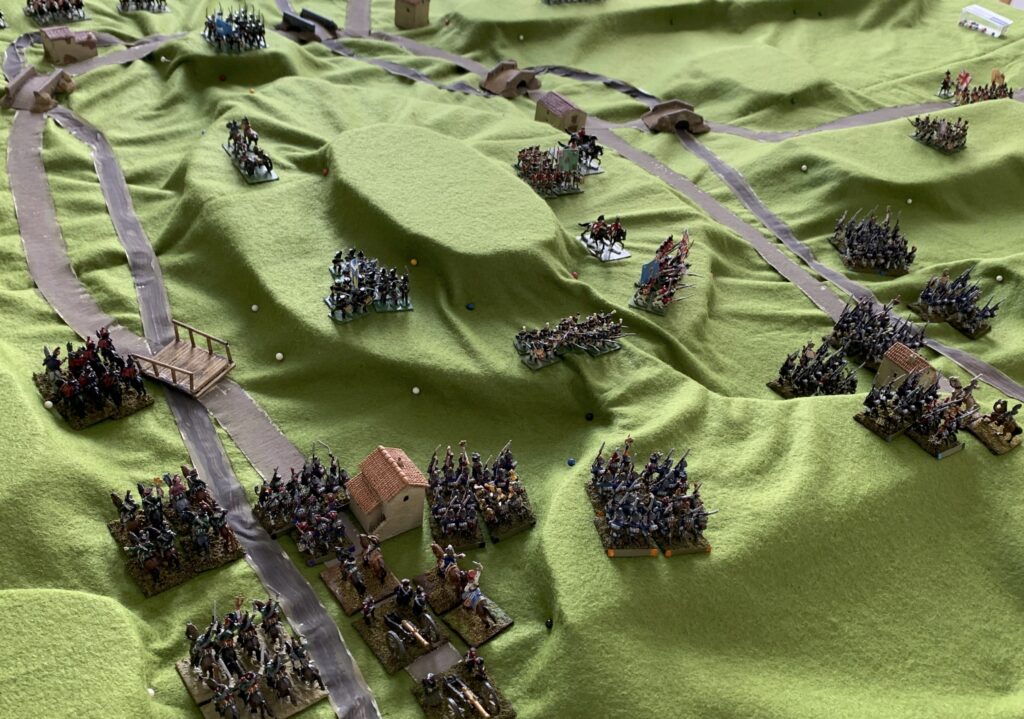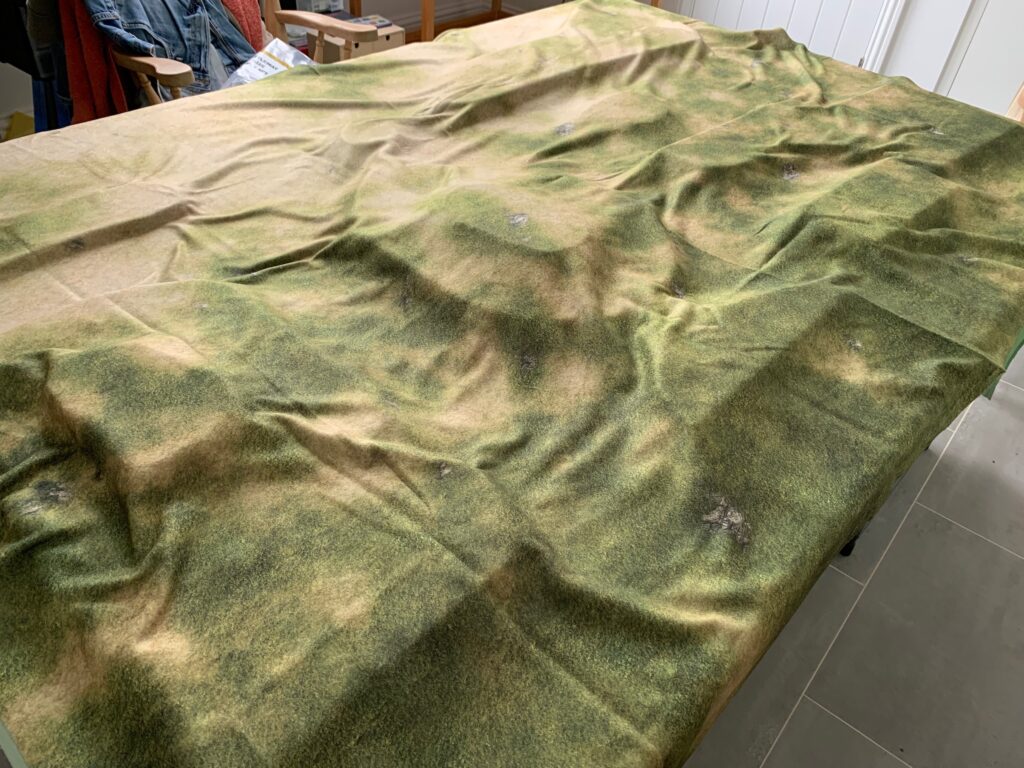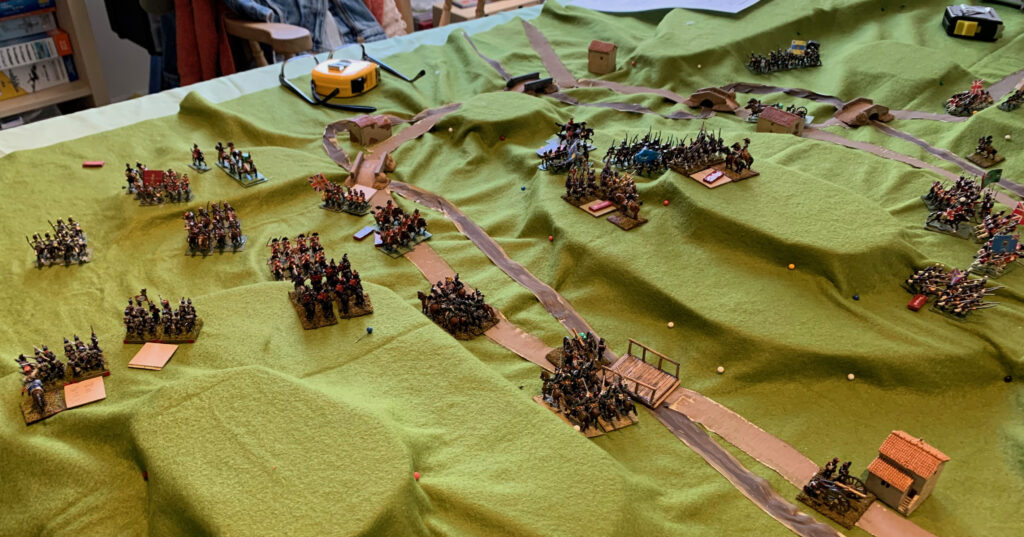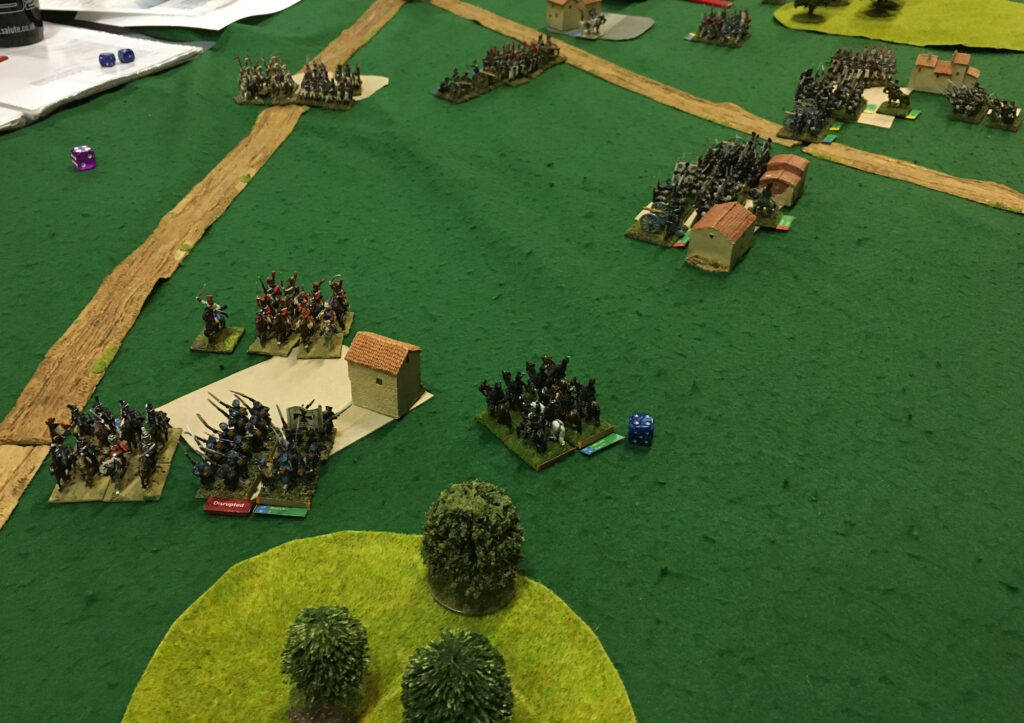
While the game structure on my new rules was falling into place, I needed to rethink the combat mechanisms. What I was looking for was both a period feel and something that players could pick up quickly, with the minimum of referring back to tables and the like.
My old system was inherited from Bloody Big Battles, which in turn adopted the Fire and Fury system. There are two types of combat: firing and assault. Fire combat covered both artillery and small arms fire, and is carried out by each side in two phases – first by the passive player after movement (“Defensive Fire”) followed by the active player (“Offensive Fire”). All firing by the relevant side is resolved simultaneously. Fire points are totalled from all sources on each target, two dice are thrown and totalled (or a single D10 for F&F), and the result looked up in a table; there are no dice modifiers, but there are “column shifts” on the table. Assault combat occurs when units are brought into contact, but not resolved until the end of the turn, after firing, which both sides in the assault participate in. The combat is resolved by each side throwing a die (all dice in BBB are six-sided; F&F uses 10-sided dice), and the modified results being compared. One side always breaks off in some form after the combat, if only by three inches.
I have never been comfortable with this system in the big-battle context, and especially without long-range infantry weapons, for which the BBB game is designed. The narrative fits much smaller encounters and much shorter turns – especially the firing. At the big game level firing was more a matter of exchange than one side firing after the other, and the distinction between close combat and short range firing is artificial. Still I stuck to it because it seemed to work, and rewriting it would be a big job. But now I can’t avoid that rewrite, because of what I am doing do with the game mechanism.
This has proved quite long journey, but I have ended up with something that seems to work, but needs more play testing. I have three forms of combat (plus some special rules for pursuits), which I am calling, for now, bombardment, firefight and assault. Bombardment covers artillery fire at longer ranges – over 3in. This fire most closely resembles the old fire system. It can be used by the active player at the start of his turn in a Bombardment Phase, or when he activates the unit; the responding player can fire too during the active player’s turn. Each time a unit fires it picks up a smoke marker; it may not gather more than two of these in a turn. I also limit ammunition to six rounds – though I may yet drop this if it doesn’t have enough impact on play. Most fire creates a fire zone which troops cannot move through in that turn – but not preparatory fire in the opening Bombardment Phase, which is meant to represent a short burst of rapid fire.
All combat is resolved as being one unit to one unit – but I do allow three artillery units to combine fire on a single target, by allowing up to two supporting units for each attack. Fire, like all combat in my new rules, is resolved by both sides throwing a die. In this case the modified throw of the firer must exceed that of the target; more hits are scored for bigger margins. Funnily enough I found that this method can be crafted to exactly replicate the old fire table in its results. Of course it is easier to combine the fire of several units using the fire points and table method – but that is not so important for my system – and having kept modifiers down to a minimum, this method is now very quick and easy. It helps to strip out short-range artillery fire, which is wrapped up into firefight and assault combat.
I seriously considered whether I could combine short range fire and assault combat into a single system, based on the old assault rules. In the old system fire by infantry units was usually fairly ineffective, and certainly quite random; you would be unlikely to use it as a serious way of engaging the enemy on its own. Infantry firing (and short-range artillery) almost always came as an adjunct to assault. It was in the rules simply to add a bit more depth and complexity to the assault, which otherwise could have had too much hanging on the throw of two dice. But then I reflected that in this era (and later ones too) there were two distinct forms of infantry combat. Apart from the classic close assault, meant to displace the enemy, forces might enter a prolonged fire combat, which would wear down the opposition, but was unlikely to yield quick results. This was tempting for armies whose troops’ morale and training made them less effective at the close quarters fighting. This style of combat should not be confused with the exchange of volleys by formed troops within 100 paces of each other – which for my purposes is another version of close combat. Instead it is what Is often referred to in English as “skirmishing”. But a skirmish implies inconsequential exchanges between small numbers of troops., when in fact it typically involved serious numbers of men over a period of time. I have called it “firefight” for want of a better word – “tirailleur combat” might be better, though it often involved more than tirailleurs – it might include artillery, and sometimes troops in more close-packed formations.
Classic wargames rules, including the BBB system, do not handle firefight combat well. They tend to have one side throwing dice to determine losses on the other side, and the other side doing the same with a separate throw, either at the same time or, as in BBB, sequentially. There are two problems. First, specifically to BBB, the fire is often ineffective, so the whole thing is a pretty pointless. In fact such combats on the grand tactical scale (when troops might blast away for half an hour or often longer) almost always had an impact, though casualties might be relatively light (the shooting was often inaccurate and the target dispersed) – because firing a musket repeatedly is physically exhausting and ammunition was not especially abundant; troops low on ammunition often refused to fight, so this was important. Better troops often prevailed because they did not burn through their ammunition so quickly, rather than because their fire was more accurate. The other big problem is that there is much too much random variation between the effects of fire between the two sides. In fact a lot of the myriad variables that are represented by the dice applied pretty much equally to both sides – visibility, range and length of time engaged in particular.
Firefight combat in my game is resolved by both sides throwing a die, as usual, with same menu of modifiers is the same for both sides. Numbers of participating bases is part of the modifier process, and supporting artillery can be brought in. First the number of hits on the active player is determined, by looking at the responding player’s modified score. This is usually one or two hits; the responding player suffers the same number of hits unless the active player’s score is four points more or less than his. That is a little complicated to describe, but it is quick when you get used to it. The result is a bit boring; both sides usually suffer one or two hits. But that is intentional – the combat is meant to be low-risk, but (usually) a drain on both sides. Of course if one side masses lots of modifiers, the outcome will not be so even.
The mechanism for assault combat is nominally similar to the old one. The result (usually) depends on the difference between the two sides’ scores, but in this one side is forced o disengage. I wanted to do away with the results table, and have a set of simple outcome rules that would replace it, which would be able to handle the differences between infantry, cavalry and artillery. I also wanted to keep dice modifiers to a minimum. One of the complexities of the old system is that of conferring advantage for numerical superiority, which involves counting bases. There is also an advantage for sides in deeper deployments, as well as the a two point advantage for flank attacks, though these were quite strictly defined. Now that combat is reduced to one-to-one encounters between single units, I had the opportunity to rethink this. I took the view that the outcome of this sort of combat was primarily about momentum. Numerical advantage conferred staying power but not much else. This simplifies things dramatically. The modifiers for numerical advantage and deep formations disappear. This is not quite accurate. If a unit had more men, and its opponent had an open flank, it did have the possibility of using its superiority to tactical advantage. I also suspect that there are differences for units that deployed extended or in depth. But it is hard to reflect these ideas without the rules become too fiddly – so I’m keeping it simple for now. I have retained the flank attack modifier, but split it between a +1 for the attacker and -1 for the defender, with a lower threshold for the former.
I have also added outcomes that reflect the absolute size of each side’s score before combat is joined. If the attacker fails to get a positive score, the attack baulks, and the defender is not engaged. If the attacker fails to get a score of 4, then the attack stalls – if the attacker is infantry, then the attack converts to a firefight; if it is cavalry, the attack does not proceed, but the target unit is pinned, which may limit its options in the next turn. On the defence side, if the assault proceeds and the defender fails to achieve a positive score it routs without combat. The 4 threshold for an attack to progress as an assault is a high one – I want to use the same set of thresholds on all my resolution procedures (i.e. 1, 4 and 7) to make them easier to remember. In fact I think it was quite hard to make troops conduct a full-blooded assault.
That’s just an overview. I am quite pleased with the overall design – the process is simple, and yet it yields a wide range of historically plausible outcomes. Whether it achieves my aim of packing more decisive action into each turn is another matter. I have this habit of providing with one hand and taking way with the other.
So that is far as I am going to describe the rules for now. I am pleased that the length of the them has actually been reduced from 14 pages to 13; it was running at 12 until the last series of tweaks. (The text is quite dense and there are no pictures…). I will only know how well they work after further play testing. Until this testing is done I won’t post up on the website. If any reader is interested in reading them before then please contact me in comments.

